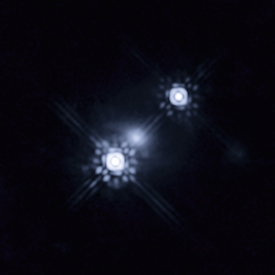100 years of General Relativity
A new frame of mind
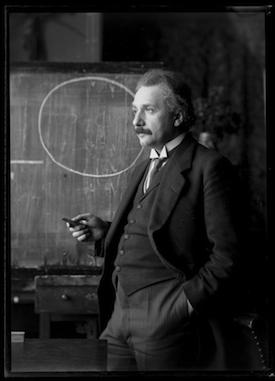 |
| Albert Einstein in 1921. Credit: ÖNB/Wien, LSCH 0075-C |
Prior to general relativity, the leading theory of gravity was Isaac Newton's law of universal gravitation, which unified the description of moving massive bodies both on Earth and in the Solar System. In Newton's framework, gravity is a long-range attractive force, acting between any two massive objects. It is directly proportional to the product of their masses and inversely proportional to the square of their distance. While Newton's theory is still a great approximation to address gravity in a variety of situations, especially in our daily life, Einstein's novel approach achieved a more complete account of gravity's behaviour, especially in extreme cases.
At the turn of the twentieth century, the only physical problem that remained unexplained within Newton's gravity was a tiny shift in Mercury's orbit. After each revolution, the planet's closest point to the Sun, or perihelion, appeared to occur at a slightly different position – this phenomenon is known as precession. Newton's theory could not fully account for the amount of this precession, up to the point that astronomers speculated about the existence of an unseen planet within the orbit of Mercury.
However, this was not the main reason that Einstein pursued a new theory of gravity. In 1905, he had developed his theory of special relativity, showing that space and time are not independent but intimately intertwined in the four-dimensional continuum of spacetime. In addition, they are not absolute, but can be seen to shrink or dilate according to the observer’s speed. In 1907, Einstein started working towards a theory that would encompass gravity, too, but he could not find a way to address it in the ‘flat’ spacetime of special relativity. Eventually, he realised that he needed to extend the description of spacetime and its structure beyond the rules of classical geometry, where parallel lines never meet and the sum of a triangle’s angles is 180°.
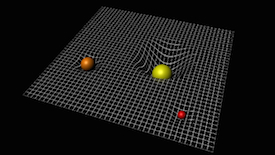 |
| Artistic view of massive bodies bending the structure of spacetime. Credit: ESA–C.Carreau |
Using the sophisticated mathematical formalism of non-Euclidean geometry, developed by Bernhard Riemann and other mathematicians in the 19th century, Einstein could describe spacetime in a more flexible way, identifying gravity as the source of its curvature. In general relativity, spacetime is not ‘flat’ but is curved by the presence of massive bodies and, as these move in spacetime, they continually change its curvature. Gravity then provides a description of the dynamic interaction between matter and spacetime.
From prediction to experiment
General relativity successfully explained the additional shift in the precession of Mercury's perihelion that could not be justified with Newton's gravity. In addition, it predicted a number of new physical phenomena that would later find experimental proof.
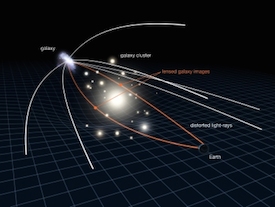 |
| Illustration of gravitational lensing. Credit: NASA, ESA & L. Calçada |
In the curved spacetime of general relativity, free-falling objects subject to gravity alone move along geodesics – the equivalent of straight lines in curved geometry. Photons, the massless particles of light, travel on special geodesics that trace the minimum path between two objects.
These trajectories are generally not straight, but can be bent if massive objects are present along the way. As seen by a distant observer, this distortion of the path of light is effectively similar to the focussing of light by an ordinary glass lens, and is thus known as gravitational lensing.
A certain degree of light distortion is predicted also within Newton's theory, and Einstein had obtained the same value in 1911, when his theory was not yet complete. With the full general relativity treatment, however, the amount of gravitational lensing exerted by a massive body on nearby passing light is twice as much.
Several teams of astronomers tried to measure during a solar eclipse how much the Sun causes the path of light from background stars to deviate, but with no success until 1919. Then, an expedition led by Arthur Eddington to Príncipe, a small island off the west coast of Africa, and a parallel expedition led by his colleague Andrew Crommelin to Sobral, in the north-east of Brazil, measured the positions of stars in a patch of the sky near the eclipsed Sun on 29 May 1919. The stars appeared to be shifted, with respect to their usual position, by the amount that Einstein had predicted with his general relativity.
The measurement of gravitational lensing during the 1919 eclipse was the first experimental proof of Einstein's theory of gravity. Gravitational lensing is now a thriving field in astrophysics, ever since the discovery, in 1979, of the first astronomical source whose light is distorted so much by the presence of a foreground galaxy that it appears as two distinct images.
Black holes, the expanding Universe and beyond
Other predictions of general relativity concern black holes, celestial bodies so dense that nothing, not even light, can escape their gravitational pull. These objects were hypothesised and studied theoretically for many decades, until the weight of observational evidence became overwhelming in the 1970s.
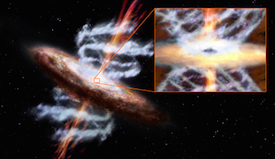 |
| Artist's impression of the supermassive black hole at the centre of a galaxy. Credit: ESA/AOES Medialab |
Numerous black holes have been discovered by studying the peculiar motion of stars and gas in their vicinity. On the one hand, there are relatively small black holes, with masses a few times more than that of the Sun, that derive from the collapse of massive stars; on the other hand, supermassive black holes, ranging from millions to billions of solar masses, are found at the centre of most massive galaxies, including our Milky Way.
The publication of general relativity also marks the birth of modern cosmology, since the theory provided a suitable framework to study gravity on the largest scales. Soon after 1915, Einstein and other physicists, including Alexander Friedman, Willem de Sitter and Georges Lemaître, started to apply the equations of general relativity to study the dynamics of the Universe as a whole. These calculations revealed an unstable Universe, either shrinking or expanding, which did not adhere to the common view at the time, envisioning a stationary cosmos, uniform in space as well as in time. Einstein tried to accommodate his equations in a stationary Universe by adding an additional term, the cosmological constant.
Interestingly, it did not take long until the astronomical observations of Vesto Slipher, Milton Humason and most notably Edwin Hubble revealed, in 1929, that galaxies outside our own appear to continually recede from one another in an overall cosmic expansion – just as had been predicted a few years earlier.
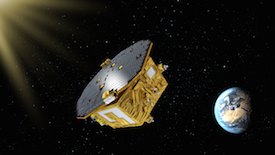 |
| Artistic view of LISA Pathfinder in space. Credit: ESA/ATG medialab |
But there is still one prediction from general relativity that eludes proof: the emission of gravitational waves – ripples in the fabric of spacetime – by any suitably accelerated massive body. While indirect evidence was found in the late 1970s by observing the feeble speeding up of two stellar remnants, a pulsar and a neutron star, in a binary system, physicists are still trying to directly detect gravitational waves with ground-based experiments and, in the future, space-borne observatories.
(Update 12 February 2016: high-frequency gravitational waves, emitted by a pair of merging black holes, were directly detected for the first time with the Advanced Laser Interferometer Gravitational-Wave Observatory.)
ESA's LISA Pathfinder mission is testing the technologies for detecting gravitational waves from space, joining the exciting quest to prove yet another prediction from Einstein's General Theory of Relativity.
Written by Claudia Mignone

